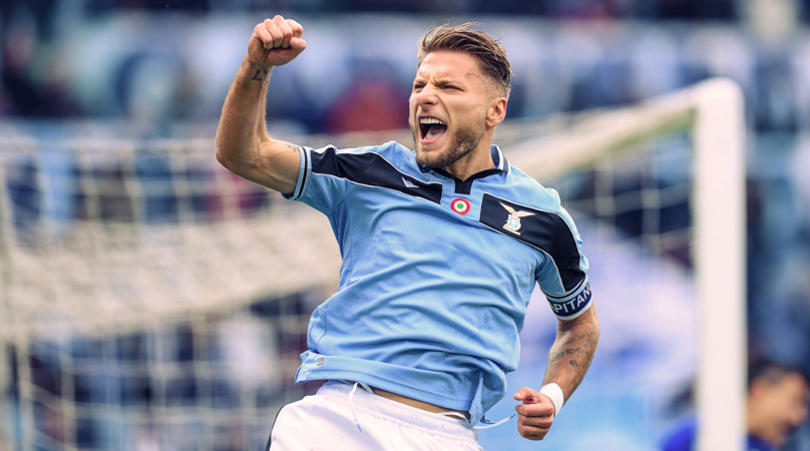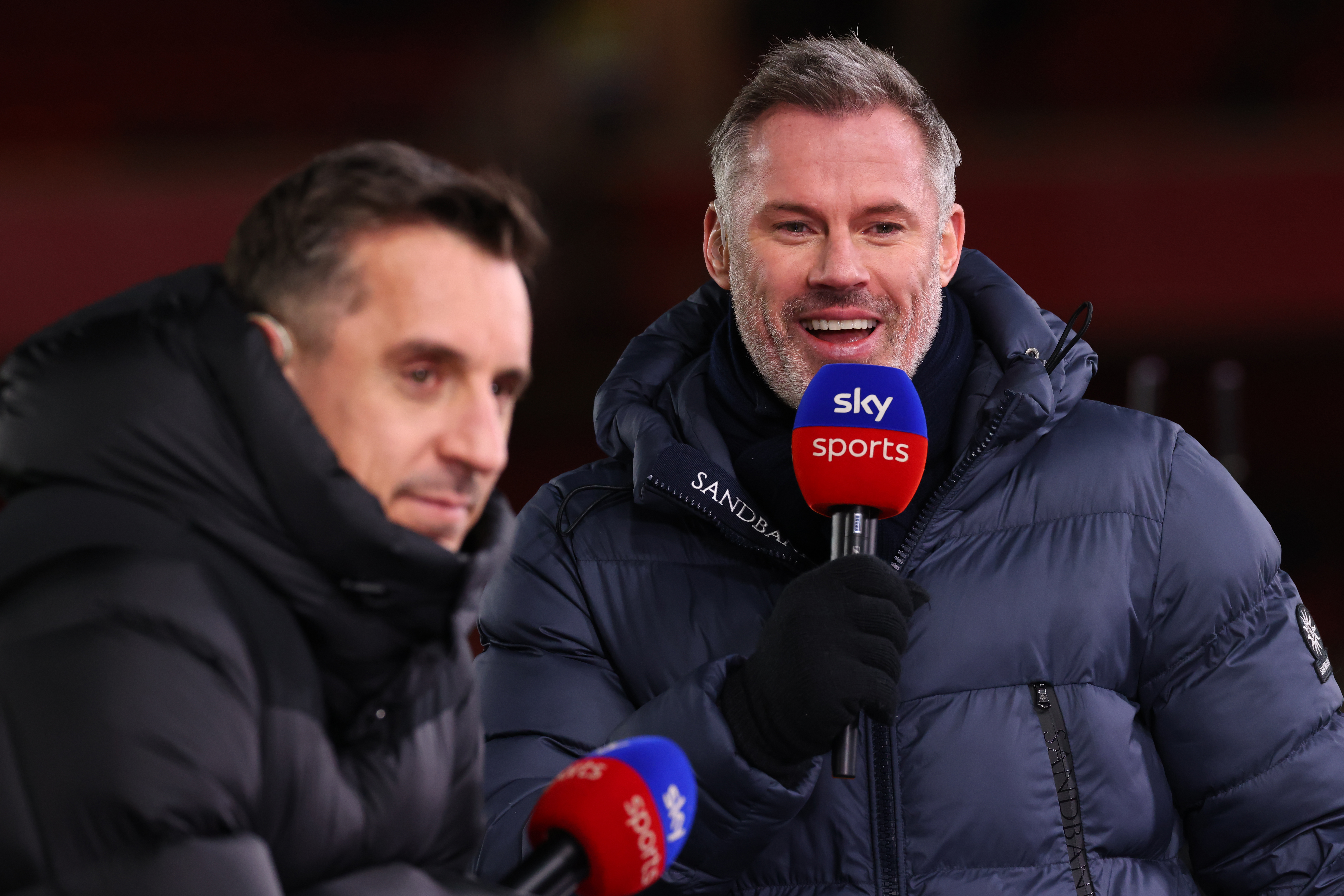Inside Lazio’s ultras: on the ground with Italy's most notorious fans
On August 7, the leader of the club’s hardcore support was shot dead. FFT heads to Rome to meet the infamous Irriducibili, left in mourning
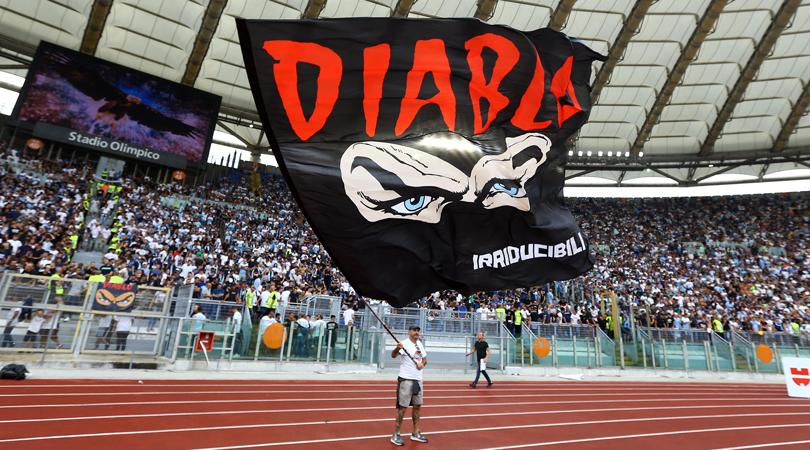
This article first appeared in the Autumn 2019 issue of FourFourTwo magazine.
What time are you arriving in Rome?” the WhatsApp message asks FourFourTwo.
“Half-past midnight.”
“You can come to our headquarters directly after you arrive in Rome.”
“Yes, but at 1.30am? Or is it better to come on Sunday morning before the game?”
“Sunday, we are very busy – 1.30am.”
“Where should I come to?”
Get FourFourTwo Newsletter
The best features, fun and footballing quizzes, straight to your inbox every week.
“We’ll let you know later.”
The headquarters belong to the Irriducibili, Lazio and Italy’s biggest ultra group. They are going to be busy tomorrow: Lazio take on arch-rivals Roma at the Stadio Olimpico and they have a curva to arrange. Even so, in 30 years of covering football in more than 80 countries, this writer has never been asked to meet anyone at 1.30am before – although the best interviews may have finished at around that time.
Then again, this meeting hasn’t exactly been easy to fix, so if it’s 1.30am, it’s 1.30am. A long day will become a long night. The ultras don’t really do media. They don’t trust media. They don’t like media. But I’ve spent much of my adult life writing about all facets of fan culture and – love them or loathe them – Italy’s ultras are a key part of that culture, with none as well known as the Irriducibili.
This derby will be especially important for the Irriducibili. Just a few weeks earlier, their 53-year-old leader, Fabrizio ‘Diabolik’ Piscitelli, was assassinated in daylight in a Rome park.
Tributes flooded in from rival ultra groups spread far and wide. On the San Siro’s Curva Nord, Inter fans organised a vast choreography in tribute before their game against Lecce. Inter and Lazio’s ultras enjoy positive relations; so, too, those in Verona. In Barcelona, meanwhile, messages were sprayed around the home of Espanyol’s ground. Back in the Italian capital, Roma’s ultras held up a banner declaring, ‘Alive we fight, dead we respect’. Flowers from Juventus’ ultras are placed on a park bench in south-east Rome, where Piscitelli was killed with a single shot to the head by a man dressed as a jogger. A day after his death, an enormous banner stating, ‘Diablo lives!’ was hung outside Rome’s historic Colosseum.
As an investigation into Piscitelli’s murder was opened by the District Anti-Mafia Directorate, Italy’s deputy prime minister, Matteo Salvini, said, “I’m sure that the professionalism of the law enforcement and investigators will resolve the case. No criminal can hope for impunity.” At the time of writing, the murderer is yet to be found.
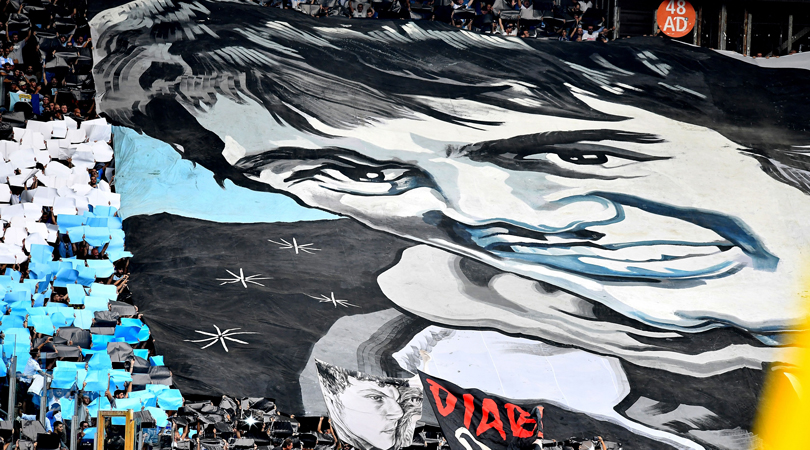
Unsure of what to expect, Italian authorities oversaw the funeral of Piscitelli. His ‘Diabolik’ nickname came from an Italian adult comic anti-hero with devil eyes. Those eyes appear on the tribute t-shirts – accompanied by the words, ‘Jackals can feast on the corpse of a lion, but he remains a lion and they remain jackals’ – and even on his coffin, which also bears the word ‘Irriducibili’.
A 6am funeral time had been suggested but in Rome, where there are different interpretations of the same laws, the funeral was finally allowed to go ahead in the Sanctuary of the Madonna of Divine Love. Only 100 people were allowed into the sanctuary, including leaders of the neo-fascist Forza Nuova party. In attendance were ultras from clubs around Europe – such as West Ham, who enjoy strong relations with Lazio. Outside, there were many chants, flares and smoke bombs.
This journalist wanted to go to Rome and write about Lazio’s ultras. From Argentina to Amsterdam, Blackpool to Belgrade, I’ve written numerous features on derby games around the world, many of them for FourFourTwo. Much time was spent with firms or hooligans from clubs, as I sought to understand why Wrexham despise Chester, and vice versa. But you can’t just wander into these groups with a polite, “Hello, I’m a British journalist.” You’ll soon be filled in – and not in the way you were hoping to be. You need a contact who can vouch for you; who trusts you. Hooligans don’t like journalists – they don’t like the reporting of what they do, and they see a lack of understanding of their culture, which goes beyond fighting.
In Wrexham, one of the main lads is a Manchester United fan, as am I. At Feyenoord and Ajax, there are contacts who can help me out. At Cardiff, a London lad knew the Soul Crew. Belgrade? That’ll be a guy in Liverpool. I don’t hide my support for the red team from Manchester, but at Manchester City or Liverpool, I’ve been writing about fan culture for long enough to know who is who. They will trust me. But at Lazio, in Rome? Nothing.
There was the waiter in a restaurant in Barcelona a few years ago who seemed to be one of the main Lazio boys, and who invited me to Rome to see a game with him. The time never came. I didn’t have his number and I called the restaurant. Nobody answered. Journalists in Italy wished me well but said I had very little chance, “especially now”, while leads drew frustrating blanks. I wanted to be on the curva, but online tickets went on sale for all parts of Rome’s vast Olimpico except the curva, where ultras stand on 18,000 bucket seats.
FFT’s application for a press pass receives no reply from Lazio, which is highly unusual. But then they didn’t respond when this magazine last visited the derby in 2008, either. That night, what stood out was what happened before the game against the Giallorossi.
Flanked by both ultra leaders, Lazio’s Tommaso Rocchi and Roma’s captain Francesco Totti walked up to Lazio’s Curva Nord, where there was a massive fan painting showing an image of Gabriele Sandri, a 26-year-old DJ who had been shot dead by police in an accident at a Tuscan motorway service station, after Lazio and Juventus fans had rioted. If hardcore fans hated anyone more than each other in Rome, it was the police, and for one game only, the ultras of both clubs had agreed to pay their respects.
Sandri’s brother stood solemnly between the two skippers with their arms joined around the rival ultra leaders – stocky, forty-something Sylvester Stallone lookalikes in caps, trainers and army trousers. The relationship between Italian players and ultras is complex, but such is their power, a living Roma deity like Totti would ignore media criticism to attend ultra meetings, funerals and weddings.
Even though Sandri was Lazio, the Roma ultras at the opposite end – figuratively and literally – filled the Curva Sud with huge banners for their hated enemies. ‘TEARS DON’T KNOW PAIN’. ‘GABRIELE, YOU ARE ALWAYS IN OUR HEARTS’. ‘GABI IS ONE OF US.’ ‘IN THE LIGHT BLUE SKY, A STAR SHINES. CIAO GABRIELE’.
Now, in 2019, Italian journalists assured us there was no chance of standing on the curva with Lazio’s ultras. Journalists were insulted at Piscitelli’s funeral, they said. They are not trusted. But why not?
Calls were made to contacts in Italy. Nothing. Then, a lad who was a Catania ultra in Sicily, a man who loves the ultra culture, agreed to ask Paolo, someone he knew in Rome. I was put in touch with Paolo, and communication slowly began between us. He said he’d speak to the head of the group, to ask if they wanted to see me.
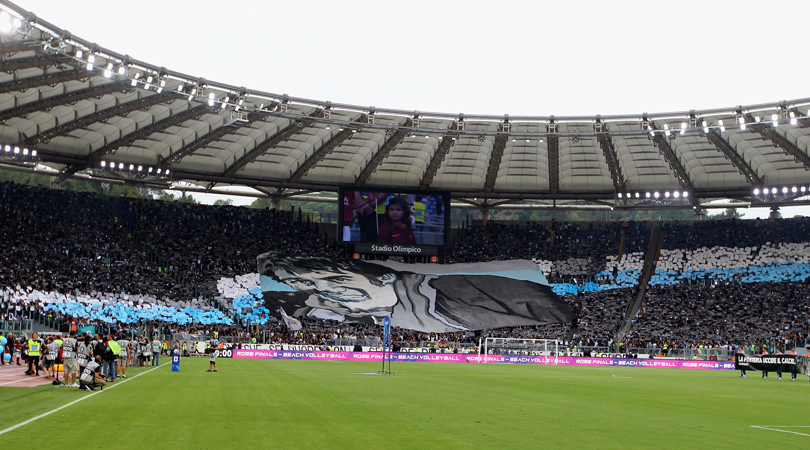
A few days later came the message to meet them at 1.30am.
As I board the plane to Rome, a further message comes in. They can now meet me tomorrow at a more encouraging 10.30am. This time there’s an address in south-east Rome. I ask if it’s possible to stand with them on the curva. “Tickets are finished,” they say. “Definitely, for the Curva Nord, no tickets. We can’t do nothing.”
At 10am on Sunday, Rome is still. I take a metro to the main Termini station, then a Line A train to Colli Albani in the south-east of the city. I walk past graffiti: ‘White power’, and someone has added the word ‘sucks’. Men in black T-shirts with ‘Diablo’ on them mooch around the headquarters in a residential area, where a flag claiming, ‘DEATH ZONE – no prisoners’ is on the door. I say hello, to a cool welcome, and hear the word ‘journalist’. I’ve had more relaxed moments.
A man comes forward, shakes my hand and speaks English. “Let’s take a coffee,” he says, and we walk over to a nearby bar. “Do you have cappuccino?” I ask. The girls behind the counter laugh. “Of course we have cappuccino,” one replies in English. The bill is taken care of.
We sit down and talk football. An elderly Lazio fan approaches; I ask him for his best moment supporting the Biancocelesti. “Winning the league in 2000,” he replies. Irriducibili come and go in the coffee bar. There are nods from the man I’m with, as if I’m being vetted for being police, or some other undesirable type.
We walk back to the headquarters, where the workers have shifted thousands of blue and white sheets to put them into cars. These cards, to be held up by the crowd, are funded by the sales of merchandise. There are other things planned, though I’m not privy to them. It’s clear that there’s a community here; a sense of belonging. On the walls are photos of ultras who have died, and banners remembering fans who have passed away. There’s also an incredible painting of hundreds of Irriducibili being escorted by a lone Alfa Romeo police car.
I’m then led upstairs, and a seat is pulled out for me to sit on. There is a knife on the desk in front of me – for cutting paper, I think, rather than anything sinister. I’m handed some water, and five men listen in.
“I am Franco, my nickname is Franchino, I am 48, and I have been supporting Lazio for 34 years,” says a man you wouldn’t want to mess with. “To be a supporter of Lazio in Rome is not the majority. Roma is the popular team; Lazio is the elite team, the noble team and the first team in Rome, founded in 1900. Our supporters do come from Rome, but we have many supporters in the Lazio regions. But we’re not Juve, Milan or Inter.” That trio of teams enjoy nationwide support.
I ask him for his greatest moment as a Lazio supporter. “When we played in the second division, we had a party,” he explains. “I enjoyed it more than playing in Serie A. It was easy to fight with other fans in the second division.”
Promotion to Serie A was achieved in 1987-88. Four seasons later, a 25-year-old Paul Gascoigne joined the club from England. “He was a revolution for us,” says Franco. “He was the first big signing of many, until 2000, when we won the league with players like Juan Sebastian Veron, Pavel Nedved and Diego Simeone.
“But we don’t want to talk about football. We are more interested in fighting! We are ultras – we are not fans.” The Irriducibili’s politics are right-wing. “Definitely right,” another man assures us.
“Rioting was important to us,” explains Franco. “Now, the police has changed, like it has in England. They will make arrests now. Can you remember when England played in Rome in 1997 and 20,000 English came to Rome? When they were here, 36 of them were arrested, and one Italian. Me. I’ve been banned from going to games. I have to give up a passport when Lazio play abroad.
Franco then moves the discussion on to a topic he knows very well. “The Irriducibili started in 1987,” he continues. “Choreography is very important for us – just as important as the match. We’re not the club; we’re separate. This is our headquarters. We meet here to talk about our plans and our flags. This is our community, our second family. I’ve divorced my wife, and I’ve known all the people here a lot longer than I’ve known her.”
I ask about the nature of his relationship with the club. “Sometimes good, sometimes bad,” he says.
Why is today’s game important? “This derby is only about Fabrizio – Diabolik – Piscitelli for us,” he explains. “In comparison, the match is not important to us. Fabrizio was our brother, our number one. We’ve seen lots of tributes for Fabrizio from all over Italy and Europe – even from Roma supporters. They respect their antagonist.”
I ask again about a ticket on the curva. “Maybe,” comes the answer, which gives me some hope.
On the ground floor, the mood is industrious, excitable and tense, as the final paper cards are loaded into the cars. On one of the walls is an image of Paolo Di Canio, whom the ultras consider as one of their own. Di Canio once sprayed, ‘Roma is s**t and their curva stinks’ on a wall in his neighbourhood. As a player in Lazio’s youth teams, he’d play on a Saturday, then travel overnight with the Irriducibili – by then Italy’s biggest ultra group – to watch the first team away from home.
“I kept the club in the dark about my travels,” admitted Di Canio. “If they had known that I spent my Sundays with the Irriducibili, visiting far-flung corners of Italy, they would probably have kicked me out of the youth academy.” He was spotted by the Lazio physio at one away game at Atalanta and warned to stay away, but it was a warning he didn’t heed. Di Canio was five yards away when the head of Bergamo’s police was stabbed.
Paolo arrives – not Di Canio – sporting his box-fresh New Balance and designer sunglasses. He’s clearly cautious, as we’ve only messaged and never met before, but he says that it’s fine to take some photos of the headquarters. We see a series of cartoon images, a painting to celebrate 30 years of the Irriducibili from 2017, and yet more pictures of ultras who are no longer with us.
Paolo lived in London for five years and he speaks excellent English. He suggests I’d be welcome to join the Lazio fans in their bar near the stadium, then says goodbye as he climbs into a car. The headquarters are locked up. Outside, there is a ‘Diablo VIVE’ image near a skull and crossbones and an Irriducibili logo. In May, a bomb was planted next to the building. They have friends, but also bitter enemies.
There are six hours to fill before kick-off. I buy a Corriere dello Sport by the Flaminio metro station and the lush Villa Borghese park, and then a message arrives from Paolo. “Andy, where are you?” he asks, before extending an invitation to join the group in a bar just north of Ponte Milvio, a beautiful, ancient, stone-arched bridge over the Tiber that dates back to the Roman Empire, and sits half a mile north of the Stadio Olimpico. A tram ride and a walk in the baking heat follow, past tennis clubs on the banks of the river, police in vans glued to mobile phones, and graffiti targeting Roma’s American owner.
In 2018, the BBC wrote about the bridge I’m about to cross, quoting a former Italian football ultra, Pierluigi Spagnolo. “Rome is the city of ‘puncicata’ – the flash stabbing, in Roman slang,” explained Spagnolo. “It is often directed at the buttocks of fans who pass the Ponte Milvio. It’s a ritual, a bad ritual. That bridge is suited to ambushes, and it’s where the Lazio ultras usually gather.”
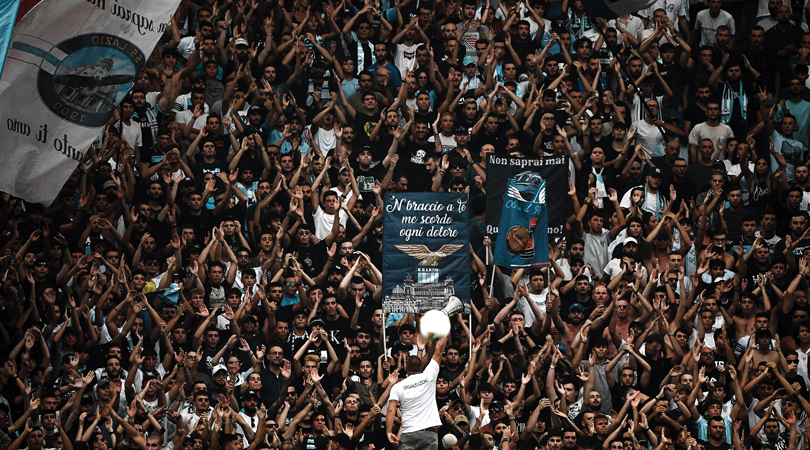
And they do. Bars to the north of the bridge, before the vast dome of the Great Mother of God church, are packed with ultras. A hardcore group, perhaps 400 strong, are around the Roma Beer Company and the place is buzzing with people greeting each other. Conscious that I’m an outsider, I call Paolo. He says he’ll be there in 30 minutes; he has things to do. It’s a long half-hour, standing by a fruit stall, trying to fit in, but it’s a fascinating place to people-watch. White Stan Smith trainers proliferate, with hints of Stone Island in this ultra tribe. A few wear West Ham T-shirts, showing a common appreciation of Di Canio. Some young Hammers have come over to see the game, in enough designer gear to keep Prada in business.
The mood builds over pre-match drinks. Everybody seems to know each other. Songs start, generally airing a view that Roma are s**t.
The Lazio eagle is a popular tattoo, though one man’s tat is in English: it says, ‘C’mon guys’. Paolo arrives. He’s friendly, as are the men I met earlier. An ultra in his twenties approaches Paolo and asks him for their West Ham contacts, as he’s going to London soon. Friendship clubs, Gemellaggi, are popular in Italy and based upon political agreement.
But Paolo shakes his head. He doesn’t know the man well enough to trust him, and doesn’t want a relationship ruined by someone he can’t fully vouch for shooting his mouth off in east London. The man walks away empty-handed.
“We don’t want to talk about football. We are more interested in fighting! We are ultras – we are not fans.”
I ask again about a ticket. Paolo says it may be possible. No money is mentioned. “Come and meet the leaders,” he says, taking me into the bar where I’m introduced to Ettore, known as ‘Pluto’, a well-built man in his early fifties. I meet him on the condition that he agrees not to mention the 1999 UEFA Super Cup Final, when Lazio beat Manchester United 1-0 in Monaco, months after they’d won the UEFA Cup Winners’ Cup. He laughs and agrees. He’s relaxed, and talks about wanting to watch derbies in England in the future. Everyone says that today is all about Fabrizio, a man well known to Italian authorities.
There’s a 15-minute queue to use the single toilet cubicle, but when I finally return, a match ticket – a season card – is passed into my hand for the middle of the curva. The season ticket is only €250. I’m in.
“Any problems, you’re with the Irriducibili,” a voice says. For the first time, I feel tolerated, but there could be issues getting in: the names on the tickets must match an official ID, which will be checked several times at the stadium.
It starts to rain, so I head into a neighbouring street bar and order a cappuccino. The staff openly laugh at me. “You should be sent to jail in Rome for ordering a cappuccino after 10am,” says an incredulous barman, before making one.
I walk back. Hundreds of motos line the streets. There are attractive women with the ultras, and one in particular isn’t short of attention now that the rain has soaked her T-shirt. Fans across the street start to sing Lazio songs, and Paolo suggests that I can walk to the ground with them, before promptly disappearing for two hours.
I call him. “I’m inside on the curva,” he says. There’s an hour until kick-off. The walk to the stadium is past so many police. Spotters film us, because I am now walking with ultras who are singing anti-police songs. We walk by the granite statues of past Olympians, and under beautiful cypress trees whose roots have cracked the concrete, making it uneven. The Stadio Olimpico was redeveloped for Italia 90 and, three decades on, it could do with a little love. Groups of lads stroll towards the turnstiles. One makes a fascist salute. Some Lazio supporters are proud of their far-right links, and Piscitelli had claimed, “We are the last fascists in Rome.”
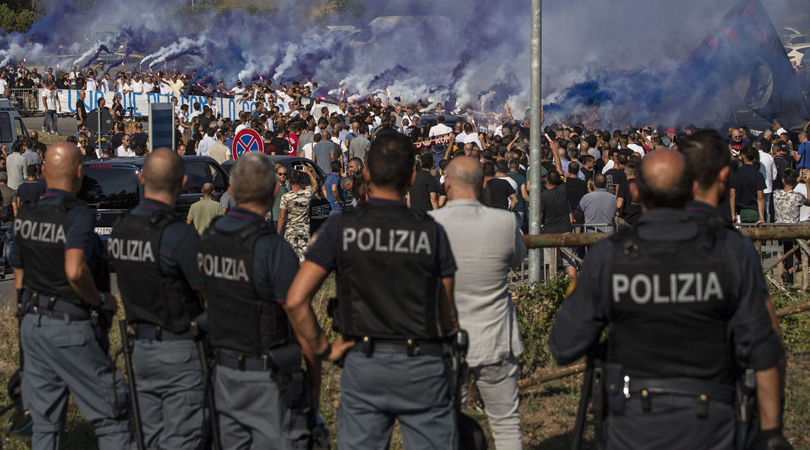
There are four ticket checks or searches. My ID doesn’t tally with my season card, but I get in without having to tell anybody that I am with the Irriducibili. For the final check, a policeman opens my bag.
“What’s that?”
“A newspaper.”
The carabinieri looks pleasantly surprised and says, “A newspaper ahead of the game – for real!”
Ultras hand out leaflets, explaining what is going to happen on the curva. Paolo and his boys have been busy. Beneath, the concourses are bleak, but the seat is in a prime spot behind the goal. The fans around me are much younger, and there is a smell of cannabis in the air. We all have blue or white cards rolled up on the seats, which nobody sits on. The stadium is two-thirds full to its 80,000 capacity. Several ultras are pitchside, one waving a large Diablo black flag with those devilish white eyes staring from it. There’s a mesmerising art to waving it well.
Bang! It’s not another firework, but a thud on the back of my head five minutes before kick-off. A flag. There is little time to be startled, as thousands of pairs of hands are working to move the 50x60m banner that has descended from behind us. It’s impossible to see what is on it, but dried paint splinters from the fabric. The flag stays above us for 10 minutes as the fans bellow ‘Forza Lazio’. It’s sweltering beneath it.
The derby has started by the time it travels down to the bottom of the stand. The leaders are gathered there, having arrived early today. British supporters arrive late to the stadium; the ultras turn up first to prepare. The only non-white face I notice is a man selling soft drinks.
The game is entertaining, but Lazio are trailing 1-0 at the interval. There have been no songs in the Lazio end, and I daren’t ask anyone why that is. In a city defaced by mass tourism, there is a community here. There are no football tourists nor selfies while the match is on.
Paolo messages me, and tells me to come to the front of the curva. I needed to see him to return my season ticket to somebody anyway. He explains, “We didn’t sing any songs during the first half, to protest against the new unconstitutional laws that the institutions have made against the ultras.
“If anybody asks who you are, say you are with me,” he adds. I ask him about the flag that passed above us. “It took 24 hours to make,” says Paolo. “Massimo ‘Disegnello’ is our main artist and has created many of these.”
I can now see that this one is decorated with an image of Diabolik. There are other flags being waved, also. One of them commemorates a Lazio fan who died during a derby in 1979, after being hit by a flare that was thrown by a Roma supporter.
The Irriducibili are proud of the Diabolik flag, and later they release a YouTube video showing the artist painting it on the warehouse floor, the flag passing over the curva, and the reaction of Diabolik’s girlfriend when she saw the flag inside the stadium. Views of the video surpass the 100,000 mark very quickly. There’s significant interest in the ultras and their activities.
Days earlier, I’d tweeted a flag of Pope John Paul II at Ibrox, which went viral. “That was a printed flag,” Paolo points out. Their pride is in making their own – in the art. There is another giant flag at the front, in honour of their murdered leader. ‘If he dies we don’t believe it,’ it reads. ‘He can be reborn again. Always with us.’
An Englishman approaches Paolo and asks permission to put ultra stickers on the terrace from his club. His request is politely declined.
The second half begins. The view from the bottom of the stand is so poor, with distance impossible to judge, that many people turn around to watch the match on the big screen at the back of the curva. Lazio equalise just shy of the hour mark, and madness erupts at the bottom of the Curva Nord, where an ultra orchestrates chants from a raised platform. The noise is immense.
Eventually, the final whistle blows. It’s dark now. The temperature in Rome finally starts to drop. The match is over, and Lazio’s Irriducibili ultras are satisfied that their Fabrizio ‘Diabolik’ Piscitelli has now been properly honoured in the Stadio Olimpico.
While you’re here, why not take advantage of our brilliant subscribers’ offer? Get the game’s greatest stories and best journalism direct to your door for only £12.25 every three months – less than £3.80 per issue! Save money with a Direct Debit today
NOW READ...
FEATURE 20 years of Jose Mourinho: The brilliant and bizarre moments of his career so far
QUIZ Can you name every Premier League team Eden Hazard scored against for Chelsea?
ANALYSIS Jadon Sancho will leave Borussia Dortmund this summer – but he shouldn't come back to England

Andy Mitten is Editor at Large of FourFourTwo, interviewing the likes of Lionel Messi, Eric Cantona, Sir Alex Ferguson and Diego Maradona for the magazine. He also founded and is editor of United We Stand, the Manchester United fanzine, and contributes to a number of publications, including GQ, the BBC and The Athletic.
